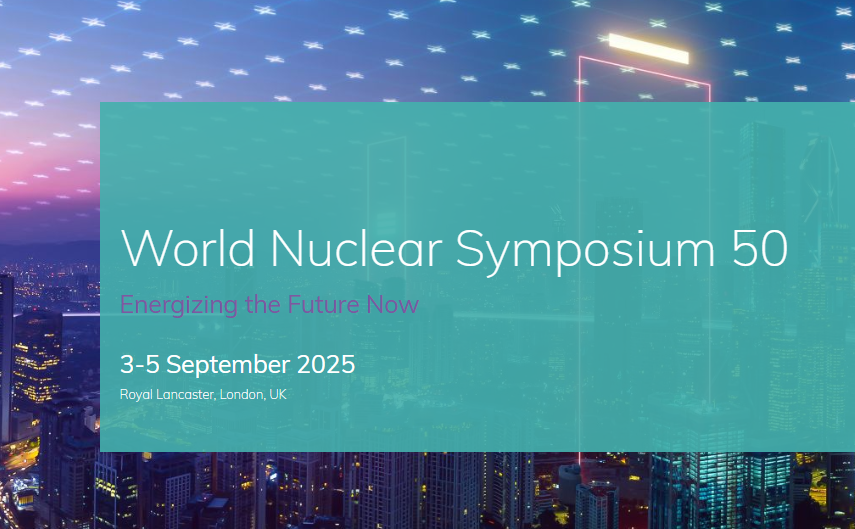
What an electrifying three days at the Royal Lancaster London! As someone who's followed the nuclear sector for years, attending Symposium 50 felt like being at the epicentre of a renaissance. The theme, "Energizing the Future Now," perfectly captured the buzz—celebrating 50 years of the event while laser-focusing on turning global commitments into concrete action. More than 1,100 delegates from 56 countries from industry, finance, tech, and policy packed the halls, and the energy was palpable: nuclear isn't just back; it's essential for AI, net-zero, and energy security. I networked like crazy over there meeting people in all levels of the industry. The Symposium was largest ever and the biggest exhibition to date.
KEY HIGHLIGHTS WERE DEFINITELY:
Two strategic summits: the Energy Users Summit and the Finance Summit ran in parallel. I found more interesting the Energy Users Summit—an electrifying start, especially since Microsoft officially joined the World Nuclear Association that morning, marking a bold new era of collaboration between tech and nuclear.
The atmosphere was charged with momentum—energy users weren’t just waiting for policy signals anymore; they were actively seeking out clean, dependable nuclear power. Leaders like Maja Lundbäck of Sweden captured the urgency perfectly: nuclear must be recognized as “a fossil-free, dispatchable baseload production.” Meanwhile, Jeremy Harrison from Saskatchewan emphasized how industry-wide demand is accelerating development—from workforce training to supply chain readiness.
I heard from X-Energy’s Ben Reinke, who didn’t mince words: “Today, the only thing holding nuclear back is capital for projects and the supply chain.” Insights like that underscored the growing role of energy users not just as customers, but as active partners and even investors. World Nuclear Association
Networking that evening was unforgettable—I mingled with peers at the Welcome Reception hosted at the Natural History Museum, a striking venue that set the tone for what felt like an era-defining event.
Today belonged to the Executive Plenary Programme, a powerhouse of leadership, strategy, and global insight. The opening addresses delivered by Dr Sama Bilbao y León and H.E. Mohamed Al Hammadi set the tone—celebrating past achievements and laying out a bold vision for the future of nuclear energy.
I was especially excited to hear Lee McDonough, the UK’s DG for Net Zero, Nuclear, and International, make clear the government’s escalating commitment: Sizewell C, SMRs, fusion investments, and a new regulatory taskforce—the UK's nuclear ambitions were unmistakable. ome was “Scaling Nuclear at Unprecedented Speed,” spotlighting how China can go from first concrete to operation in just 56 months—a powerful reminder of what’s possible when policy, industry, and innovation align.
Beyond the plenaries, I explored the sprawling exhibition hall, its largest-ever footprint, brimming with innovation—everything from advanced SMRs to data-driven optimization tools.
That evening, the Gala Dinner brought the community together in style. Hosted by Cameco at Exhibition White City, the event was both elegant and energizing. The table I choose had a couple of interesting people from Orano, Japanese utilities and CEOs. Learned a lot over fine drinks and food.
I started the day with momentum carried from the previous sessions—Dr Bilbao y León opened with “Energizing action,” rallying everyone from lofty goals to tangible delivery.
One of the standout moments was the release of the World Nuclear Performance Report 2025—it revealed that 2024 saw record-breaking nuclear electricity generation globally. It felt like a rallying cry: the foundation is here, now it’s time to scale.
Alongside that, the World Nuclear Fuel Report made waves—highlighting how uranium demand is accelerating while mine supply shrinks. Utilities will need to lock in supply earlier, and miners and investors face a golden opportunity in a tightening market.
Throughout the day, sessions on nuclear fuel, Africa’s emerging markets, India’s ambitions, and supply chain acceleration added layers of insight and urgency to the conversation. Though not all details were in the sources I’ve accessed, the undercurrent was clear: the industry is at a crossroads of expansion—but one that hinges on delivery, partnerships, and global strategy.
There were a lot of meetings between companies, certain funds where you could feel the conversation about M&A in the air. I talked to almost all the uranium companies CEOs there to get a complete insight into the plans of these companies and the way of thinking of their executives. I had a chance to talk to Mike Alkin, John Borshoff, Grant Isaac, Per Jander, Nick Lawson, Ben Finegold, Dustin Garrow, John Ciampaglia, Corey Dias, Thomas Lamb, Stephen Roman and many others.
I closed the Symposium with a feeling: this wasn’t just a meeting—it was a launchpad. Across those three days, ambition, action, and collaboration aligned in a way I’ve not seen before. I left energized, connected.
The symposium was not cheap, but it is worth every penny!
In the next couple of days I will try to digest the Fuel Report. It has 290 pages with a lot of info. What I saw so far it all comes to
Less cheap uranium available
Investment & project pipeline lagging
Long mine lead times
Geopolitical instability in key suppliers
Declining secondary supply
Volatile production patterns
Thanks.
Lucijan
Sign up to our free monthly newsletter to recieve the latest on our interviews and articles.
By subscribing you agree to receive our newest articles and interviews and agree with our Privacy Policy.
You may unsubscribe at any time.
We use cookies to improve your experience on our site. By using our site, you consent to cookies.
Websites store cookies to enhance functionality and personalise your experience. You can manage your preferences, but blocking some cookies may impact site performance and services.
Essential cookies enable basic functions and are necessary for the proper function of the website.
These cookies are needed for adding comments on this website.
Statistics cookies collect information anonymously. This information helps us understand how visitors use our website.
Google Analytics is a powerful tool that tracks and analyzes website traffic for informed marketing decisions.
Service URL: policies.google.com
You can find more information in our Privacy Policy.